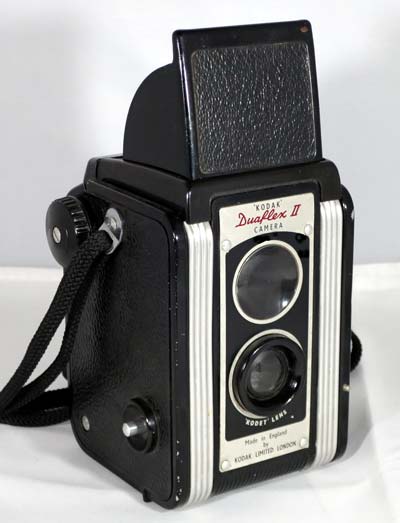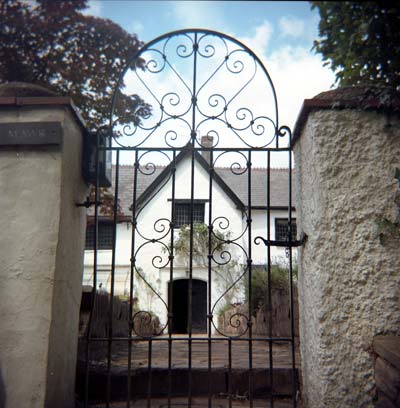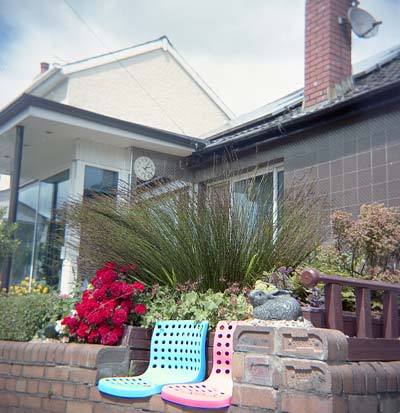Kodak Duaflex II
Specification

| Manufacturer | : | Kodak (UK) |
|---|---|---|
| Produced | : | 1955 - 1960 |
| Classification | : | Medium Format |
| Body Type | : | Pseudo Twin Lens Reflex |
| Construction | : | Bakelite/Metal |
| Film Type | : | 620 |
| Film Width | : | 62mm |
| Image Size | : | 2¼ x 2¼ in |
| No. of Images | : | 12 |
| Lens Type | : | Kodet Meniscus |
| Focus Type | : | Fixed |
| Focal Length | : | 70mm |
| Focus Range | : | 5ft to inf, |
| Aperture Type | : | Fixed |
| Aperture | : | f/14 |
| Shutter Type | : | Rotary |
| Shutter Speeds | : | B, I*(1/30 sec) |
| Size (w x h x d) | : | 80 x 115 x 80 mm |
| Weight | : | 450g |
| * measured on this camera | ||
Art Deco Credentials
![]()
![]()
Acceptable: Modest and restricted
- Produced after the main Art Deco period;
- Aluminium ribbed detail to top and each side;
- Rounded corners from the streamline era;
- Ribbed detailing on front;
- Lined detailing to leatherette on rear;
- Chrome winder and film door latch.
- Symmetrical Design
Description
The Kodak Duaflex II is a twin-lens reflex style box camera from the 1950s. It is an improved version of the Duaflex I. It can be described as a pseudo twin lens reflex camera. It isn't a true TLR because the top lens is just part of the viewfinder and does not aid focussing. It was originally available in the US from 1950. The US version had an f/8 focussing lens although the focussing was not coupled to the viewfinder. It has aluminium ribbed detail to top and each side of the lenses. On the US model the ribbed detail is enamelled black. The corners are rounded indicative of the Streamline Moderne period. The reflecting finder is very large and bright. The finder has a folding hood which was not available on the Duaflex I model. Flash synchronisation is by the 2-pin flash contacts on the side and the use of a Kodalite Flasholder. It was part of a four model series - I, II, III, IV. They were designed as cheap, lightweight and easy to operate twin lens cameras made from Bakelite. These cameras used 620 film for 2¼ x 2¼ inch square pictures.
How to Use
See Instruction Manual here. This camera takes 620 film which is still available from selected photographic outlets. Although the actual film is the same as 120 film, the spools are different. The 620 spools are slightly shorter and have a smaller diameter. Do not use 120 film in this camera because it will jam and may snap. It is possible to cut down a spool of 120 film to fit or to re-spool some 120 film onto 620 spools in a darkroom or changing bag. Don't forget to ask for your 620 spool back when getting the film developed.
As the shutter speed is only 1/30s, it is advisable to use a tripod to get clear shake free images. However, holding it against a wall or other solid object would work as well. For quick snapshots, hold it firmly against your body.
If you don't want to bother with an exposure meter, follow the guide shown. It is based on the 'Sunny 16' rule. Film is so forgiving and will produce acceptable results even when overexposed by 2 or 3 stops or underexposed by 1 stop.
The tables assume that the sun is at least 30 degrees above the horizon - that's 10am - 5pm on a summers day in the UK.
Remember that the exposure guide in the manual may not be helpful as it is based on the use of old film with a low ISO value.
Using ISO 100/125 film - shutter speed 1/30s
| Weather Conditions | Shadow Detail | Aperture | Exposure |
|---|---|---|---|
 Sunny SunnySnow/Sand | Dark with sharp edges | f/14 | +3 Stops Overexposed Acceptable |
 Sunny Sunny | Distinct | f/14 | +2 Stops Overexposed Acceptable |
 Slight Overcast Slight Overcast | Soft around edges | f/14 | +1 Stops Overexposed Acceptable |
 Overcast Overcast | Barely visible | f/14 | Good |
 Heavy Overcast Heavy Overcast | None | f/14 | -1 Stop Underexposed Acceptable |
 Open Shade Open Shade/Sunset | None | f/14 | -2 Stops Underexposed Not Acceptable |
Photographs taken with this Camera
Kodak Portra 160 film. Developed in Tetenal.



